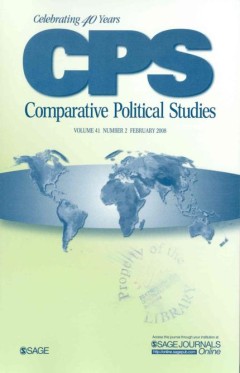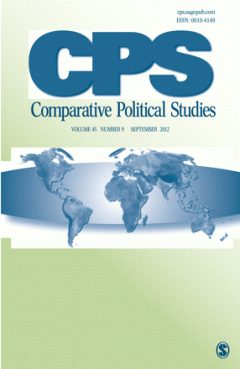Filter by

Government Responsiveness and Political Competition in Comparative Perspective
Governments in democratic systems are expected to respond to the issue preferences of citizens. Yet we have a limited understanding of the factors that cause levels of responsiveness to vary across time and between countries. In this article, the authors suggest that political contestation is the primary mechanism driving policy responsiveness and that this, in turn, is mediated by politi…
- Edition
- Vol. 41, No. 3, Page 309-337
- ISBN/ISSN
- 0010-4140
- Collation
- -
- Series Title
- Comparative Political Studies
- Call Number
- -

Understanding Cleavages in Party Systems: Issue Position and Issue Salience i…
There has been considerable debate about the characteristics of political cleavages underlying post-Communist Central and Eastern European party competition, with views ranging from no structure, to unidimensionality, to structured diversity, to entirely sui generis country-specific approaches. Much of the disagreement, the authors argue, results from the failure to take seriously the distincti…
- Edition
- Volume 42, Number 2, February 2009. pp. 280-313
- ISBN/ISSN
- 00104140
- Collation
- -
- Series Title
- Comparative Political Studies
- Call Number
- -

Are Parliamentary Systems Better?
The institutional differences between presidential and parliamentary rule are well known, yet the practical effects of these divergent constitutional arrangements within democratic polities have received scant attention. This article employs a global data set to test the relationship between a historical measure of parliamentary rule and 14 indicators ranging across three policy areas: politica…
- Edition
- Volume 42, Number 3, March 2009 327-359
- ISBN/ISSN
- 0010-4140
- Collation
- -
- Series Title
- Comparative Political Studies
- Call Number
- -

Constructing Tolerance: How the Welfare State Shapes Attitudes About Immigrants
Over the past 30 years, the hitherto rather homogeneous welfare states in Europe have been experiencing a dramatic influx of immigrants, making them much more diverse. The central purpose of the early development of the welfare state was twofold: to bridge class divisions and to mollify ethnic divisions in the vast multiethnic empires of 19th-century Germany and Austria. This research examines …
- Edition
- Volume 42, Number 3, March 2009. pp. 437-463
- ISBN/ISSN
- 0010-4140
- Collation
- -
- Series Title
- Comparative Political Studies
- Call Number
- -

The Global impact of quotas: on the fast track to increased female legislativ…
Quotas have become an important mechanism through which women today are entering legislatures worldwide. This study shows that the introduction of quotas has helped overcome constraints on women's representation posed by economic underdevelopment, cultural influences, and even electoral systems. This study also demonstrates that the introduction of quotas offers the most explanatory power for w…
- Edition
- Vol. 41, No. 3, Page 338-361
- ISBN/ISSN
- 00104140
- Collation
- -
- Series Title
- Comparative Political Studies
- Call Number
- -

In the Shadow of Democracy Promotion: Strategic Manipulation, International O…
International efforts to promote democracy can have unanticipated effects. International election observation is perceived to increase domestic confidence in the electoral process and reduce fraud. Conversely, election boycotts are perceived to be more likely as electoral fairness decreases. The authors document a puzzling relationship between monitored elections and opposition party boycotts: …
- Edition
- Volume 42, Number 3, March 2009. pp. 392-415
- ISBN/ISSN
- 00104140
- Collation
- -
- Series Title
- Comparative Political Studies
- Call Number
- -

From Patronage to Program: The Emergence of Party-Oriented Legislators in Brazil
This article explains the unanticipated emergence of party-oriented legislators and rising party discipline in Brazil since the early 1990s. The authors contend that deputies in Brazil became increasingly party oriented because the utilities of party-programmatic and patronage-based electoral strategies shifted with market reforms that created a programmatic cleavage in Brazilian politics and d…
- Edition
- Volume 42, Number 3, March 2009. pp. 360-391
- ISBN/ISSN
- 00104140
- Collation
- -
- Series Title
- Comparative Political Studies
- Call Number
- -

On the Duration of Political Power in Africa: The Role of Oil Rents
It is often underlined that African oil-producing countries are politically unstable as a result of the role that this resource can play in political incentives. Based on data documenting the duration in office of heads of state of 26 African countries (North Africa and sub-Saharan Africa), this study reveals a surprising twist on the conventional wisdom: The purported instability of African oi…
- Edition
- Volume 42, Number 3, March 2009. pp. 416-436
- ISBN/ISSN
- 00104140
- Collation
- -
- Series Title
- Comparative Political Studies
- Call Number
- -

A Deeper Look at the Proportionality—Turnout Nexus
Evidence that turnout is higher under proportional representation (PR) than in majoritarian elections is overwhelming. Yet previous research has largely failed to explain why. One line of argument maintains that higher turnout under PR is a by-product of larger party systems. However, a larger number of parties has been demonstrated to depress turnout. Alternatively, it is argued that majoritar…
- Edition
- Volume 42, Number 4, April 2009. pp. 527-548
- ISBN/ISSN
- 0010-4140
- Collation
- -
- Series Title
- Comparative Political Studies
- Call Number
- -

Dominant Party Regimes and the Commitment Problem: The Case of United Russia
This article analyzes the formation of a stable dominant party in an authoritarian regime as a commitment problem between two sides: the ruler and other elites. After defining a dominant party regime and outlining the costs and benefits that such a regime entails for each side, the authors examine the efforts made in Russia to establish United Russia as a dominant party and argue that the Kreml…
- Edition
- Volume 42, Number 4, April 2009. pp. 501-526
- ISBN/ISSN
- 0010-4140
- Collation
- -
- Series Title
- Comparative Political Studies
- Call Number
- -

Supporters or Challengers?: The Effects of Nongovernmental Organizations on L…
How do nongovernmental organizations (NGOs) affect local politics in developing democracies? Specifically, do NGOs have systematic effects on the fortunes of incumbent political parties in local elections? Existing work predicts starkly contradictory political effects: Some scholars claim that NGOs most likely help incumbents by providing services for which politicians can claim credit, whereas…
- Edition
- Volume 42, Number 4, April 2009. pp. 479-500
- ISBN/ISSN
- 00104140
- Collation
- -
- Series Title
- Comparative Political Studies
- Call Number
- -

Learning From Others:The Diffusion of Hospital Financing Reforms in OECD Coun…
The increase in health care expenditures is a major problem of all welfare states. To counter this trend, since the early 1980s, most OECD countries have changed the way hospitals are financed. Although these reforms are certainly linked to country-specific factors, the authors' main argument is that they are in part due to a diffusion process: Policy change in one country is influenced by prev…
- Edition
- Volume 42, Number 4, April 2009. pp. 549-573
- ISBN/ISSN
- 0010-4140
- Collation
- -
- Series Title
- Comparative Political Studies
- Call Number
- -

The Armed Forces and Transitions from Authoritarian Rule: Explaining the Role…
Studies of transitions from authoritarian rule have shown that militaries play decisive roles in authoritarian breakdowns. The military possesses coercive resources that can suppress any challenge to authoritarian rule. This article explains why and under what conditions militaries in authoritarian regimes, when faced with popular demonstrations, will support the path of political liberalizatio…
- Edition
- Volume 42, Number 5, May 2009. pp. 640-669
- ISBN/ISSN
- 00104140
- Collation
- -
- Series Title
- Comparative Political Studies
- Call Number
- -

What Moves Parties?: The Role of Public Opinion and Global Economic Condition…
Do Western European political parties adjust their ideological positions in response to shifts in public opinion and to changing global economic conditions? Based on a time-series, cross-sectional analysis of parties' ideological dynamics in eight Western European democracies from 1976-1998, the authors conclude that both factors influence parties' ideological positions but that this relationsh…
- Edition
- Volume 42, Number 5, May 2009. pp. 611-639
- ISBN/ISSN
- 00104140
- Collation
- -
- Series Title
- Comparative Political Studies
- Call Number
- -

Strategic Targeting: The Effect of Institutions and Interests on Distributive…
Virtually every government provides distributive transfers for electoral purposes. However, the level and form of such transfers vary dramatically across countries. Although transfers take many forms, they can generally be characterized as being either broad (providing benefits to large segments of the electorate) or narrow (targeting benefits only to select groups of voters). Variation in the …
- Edition
- Volume 42, Number 5, May 2009. pp. 670-695
- ISBN/ISSN
- 0010-4140
- Collation
- -
- Series Title
- Comparative Political Studies
- Call Number
- -

The Role of Interfirm Networks in Technological Innovation and Education
This article examines the sociopolitical conditions for preventing market failure in public goods investment. Based on International Social Survey Program data for 17 advanced industrialized countries, the author compares economies with strong and weak institutions of interfirm coordination in how they encourage investment in skills and technological innovation and highlight the inefficiency of…
- Edition
- Volume 42, Number 5, May 2009. pp. 587-610
- ISBN/ISSN
- 0010-4140
- Collation
- -
- Series Title
- Comparative Political Studies
- Call Number
- -

Insiders, Outsiders, and the Politics of Corporate Governance: How Ownership …
This article argues that differences in the dispersion of corporate ownership help to explain why party positions on corporate governance vary across countries and over time. It shows that British, French, and German political debates over takeover regulation since the 1950s differ significantly along several dimensions, including the pattern of left�right competition and the timing of debate, …
- Edition
- Volume 42, Number 6, June 2009. pp. 733-762
- ISBN/ISSN
- 0010-4140
- Collation
- -
- Series Title
- Comparative Political Studies
- Call Number
- -

The Origins of Social Capital: Evidence From a Survey of Post-Soviet Central …
This article investigates the determinants of social capital by analyzing an original survey of post-Soviet Central Asia. It tests hypotheses derived from two related questions: whether networks, norms, and trust are empirically related and the extent to which four factors�culture, regime type, perceptions of government responsiveness, and development interventions�predict levels of social capi…
- Edition
- Volume 42, Number 6, June 2009. pp. 707-732
- ISBN/ISSN
- 0010-4140
- Collation
- -
- Series Title
- Comparative Political Studies
- Call Number
- -

Ideological Consistency and Attitudinal Conflict:A Comparative Analysis of th…
According to attitudinal theorists, justices on the U.S. Supreme Court decide cases largely on political preferences that fall within one dimension of ideology. The focus of this study is to test whether a unidimensional ideological model explains the voting behavior of Canadian Supreme Court justices (1992�1997). The factor-analytic results in three areas of law, two of which have never been e…
- Edition
- Volume 42, Number 6, June 2009. pp. 763-792
- ISBN/ISSN
- 0010-4140
- Collation
- -
- Series Title
- Comparative Political Studies
- Call Number
- -

The Making of Mavericks: Local Loyalties and Party Defection
By focusing on parliamentary systems, this article presents an argument that legislators who have strong local ties and individual support bases are more likely to be individualistic and so break party unity in parliament. They are simply less dependent on parties for their careers, political and otherwise. The article draws on an original data set of legislators' votes and their biographies fr…
- Edition
- Volume 42, Number 6, June 2009. pp. 793-815
- ISBN/ISSN
- 0010-4140
- Collation
- -
- Series Title
- Comparative Political Studies
- Call Number
- -
 Computer Science, Information & General Works
Computer Science, Information & General Works  Philosophy & Psychology
Philosophy & Psychology  Religion
Religion  Social Sciences
Social Sciences  Language
Language  Pure Science
Pure Science  Applied Sciences
Applied Sciences  Art & Recreation
Art & Recreation  Literature
Literature  History & Geography
History & Geography